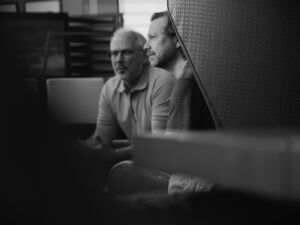AI changed how we write code but it also changed how we think about who writes it, how it gets validated, and what teams need to trust it. For Leapter co-founders Robert Werner and Oliver Welte, that shift wasn’t just technical, it was personal. This is the story of how two longtime software leaders saw the cracks in modern development workflows, and set out to build something radically different: a visual-first, AI-native platform designed not for speed alone, but for clarity, collaboration, and trust.

Leapter co-founders Robert Werner and Oliver Welte.
In 2024, something shifted.
AI wasn’t new, but suddenly, it was everywhere. Large Language Models were rewriting what we thought was possible, including the way software got built. Code generation tools exploded onto the scene. You could describe a function in plain language, and out came working code. For developers, it felt both magical and unsettling.
For Robert Werner, it was a wake-up call.
“I realized this was the moment,” Robert says. “The pace of change in AI meant there were gaps—real ones—between what businesses needed and what software teams could reliably deliver. I didn’t want to sit on the sidelines.”
He started exploring startup ideas. Actively. Consciously. And then, a story from a friend, an enterprise developer working at a bank, pushed everything into focus.
The friend had just left a frustrating meeting. A business analyst told him, point-blank, that his help might soon be unnecessary. With AI, the analyst said, they could just describe what they wanted and let the system generate the code directly.
“For him, it felt like a threat,” Robert recalls. “But for me, it was an aha moment. Not because I believed the claim—it was naïve—but because it showed how far the perception had shifted. And how much confusion and risk that introduced.”
Robert didn’t believe AI would replace developers. But he did believe this moment of change revealed something deeper: a misalignment between how people think about software and how it’s actually built. That tension became the seed of Leapter.
To bring the idea to life, Robert teamed up with Oliver Welte, a former colleague from their time at Pivotal. The two had helped large German enterprises modernize their development processes, introducing agile, XP, and platform thinking before it was fashionable. They knew how complex software got made in the real world, and how hard it was to align business intent with engineering execution.
“I actually interviewed Robert for his role at Pivotal,” Oliver laughs. “That’s where it all started.”
But this time, they weren’t joining a transformation project. They were starting a company. And as they both point out, they didn’t exactly fit the stereotype of the hoodie-wearing 22-year-old founder.
“Two guys in their fifties, with no startup pedigree? We knew we’d have to prove ourselves,” Oliver says. “But we also knew we had something real. And a network of serious, experienced people who could help us shape it.”
Their vision was ambitious: Build a tool that helps teams move from idea to working software, but do it in a way that prioritizes clarity, not just speed. A tool that didn’t just spit out code, but let teams see and understand what the AI was doing. A way to collaborate around logic, not just copy-paste suggestions.

Robert Werner, co-founder of Leapter.
The challenge, as Robert saw it, had two parts.
“First, there was the logical part: how could a team—even a non-technical one—actually interact with what the AI generates? How do you give people something they can validate and shape?”
That question pulled from Robert’s past experience. He had worked at a company that specialized in making complex systems understandable to business stakeholders, using visual models to represent logic and flows. That mental model became a core influence on Leapter’s approach: make the logic visible. Make it explainable. Make it collaborative.
The second stream was feasibility. Could they actually build it?
“At that time, early 2024, LLMs were still evolving fast,” Robert explains. “But I had a strong network of engineers playing with cutting-edge models. We started validating ideas early, doing small experiments to test what was technically possible. And we realized: this wasn’t science fiction. We could build this.”
Of course, ideas are the easy part.
Neither Robert nor Oliver had ever raised venture capital. So the learning curve was steep. Robert began testing the waters and reaching out to people in his network, asking for feedback, and practicing his pitch with anyone who would listen. A friend in Scotland connected him with a VC, who, despite the lack of a deck, told him the idea was in the top 5% of pitches he saw.
That gave Robert confidence. Enough to take a family vacation detour to San Francisco to meet with former colleagues and see what the Valley thought.
“I thought maybe this would be the story: go to Silicon Valley, pitch the idea, get funded,” he admits. “But that’s not how it works. That trip was humbling. It made me realize we’d have to do this the hard way.”
Back in Germany, things clicked. Through a serendipitous connection, they met Frank Stummer, who had written his PhD on startup success criteria. Frank believed in them. He didn’t offer a check right away, but he did offer something better: time.
“He said, let’s meet regularly. I’ll coach you. I’ll help you shape the business plan. I’ll show you how to pitch.” —Robert
Frank became a critical part of Leapter’s founding story by helping them refine their pitch, build their financial model, and eventually connect with Smart Infrastructure Ventures, which gave them a soft commitment. Later, bm|t (Thuringia’s investment fund) joined as lead investor.
“We learned quickly,” Oliver adds. “There’s a whole playbook to raising money. What a ‘soft commit’ means, what a ‘lead investor’ is—it was a new language. But we had help. And we stayed persistent.”

Oliver Welte, co-founder of Leapter.
So what is Leapter, really?
It’s not a low-code tool. It’s not an assistant. It’s not a black box.
It’s a visual, AI-native platform for building systems you can trust. It lets domain experts, product managers, and developers work together, turning business intent into structured, auditable logic that generates real, production-grade software.
“We’re not just writing code,” Robert explains. “We’re helping teams understand what’s being built—and why. Understanding leads to trust. And trust is what unlocks speed.”
That’s why Leapter doesn’t just generate output. It makes the logic visible. It invites feedback early. It surfaces assumptions. And it ensures humans—not just machines—stay in the loop.

Leapter co-founders Robert Werner and Oliver Welte.
The last few months have been a whirlwind. The Leapter team launched their prototype on stage at WeAreDevelopers in Berlin. They hosted a launch party. They added new hires. Their inbox is full of demo requests.
“We’ve done the demo,” says Oliver. “Now we’re building. Fast.”
The roadmap ahead is clear: refine the product, support early adopters, and scale the team. But the mission remains grounded:
“We want to help teams build systems they can understand, validate, and trust,” Robert says. “That’s what’s missing in most AI tooling today. And that’s the gap we’re closing.”
... let's celebrate!!!